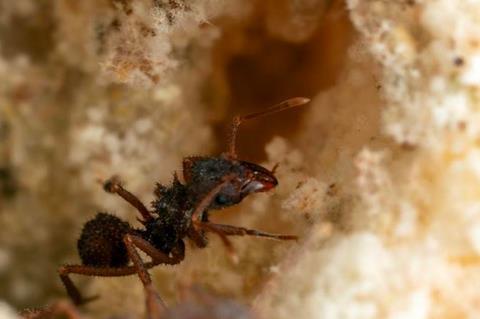A study investigates the evolution of beneficial bacteria that live inside and on the surface of farming ants. Attine ants farm fungi, in one of the natural world’s best-studied mutualistic symbioses.In the 1990s, the picture of this mutualism was expanded to include another partner: an actinobacteria, Pseudonocardia, which lives on the ants’ cuticle—their hard exoskeleton—where its cultures are fed by secretions of subcuticular glands.

READ MORE: Asteroid that doomed dinosaurs created fungus farming amoung ants
READ MORE: Ants recognize infected wounds and treat them with antibiotics
Pseudonocardia is known to kill the fungal pathogen Escovopsis, that might destroy the ants’ mutualistic fungus. Jacobus J. Boomsma and colleagues sequenced samples from 194 ants from 11 attine species collected in Panama to assess the extent of coevolution between ants and their cuticular residents.
Attine ants evolved to host cuticular bacteria
Three of the 11 attine species had abundant Pseudonocardia, including two Acromyrmex leaf-cutting ants. Five other species had cuticular actinobacteria other than Pseudonocardia, with no clear phylogenetic patterns.
The authors examined the ants’ nourishment glands with transmission electron microscopy, revealing similar structures across species, suggesting that attine ants evolved structural and functional adaptations for hosting cuticular actinobacteria only once, shortly after the origin of fungus farming. Clearly, however, the glands are capable of nourishing bacterial strains other than Pseudonocardia.
Comparing phylogenies of ants and their cuticular and gut Pseudonocardia indicates that Pseudonocardia were initially gut symbionts and became cuticular symbionts late in attine evolution, around 20 million years ago, coincident with the evolution of new genera in Central/North America. According to the authors, earlier contradictory findings can be explained by not separating guts and cuticles during sequencing, and because ants easily acquire non-natural actinobacteria when held for longer periods in lab settings.
Topics
- Acromyrmex leaf-cutting ants
- Actinobacteria
- ants
- attine ants
- Bacteria
- cuticle
- Escovopsis
- fungi
- fungus farming
- genomic sequencing
- Healthy Land
- Jacobus J. Boomsma
- mutualistic fungi
- mutualistic symbioses
- Mycetomoellerius zetecki
- nourishment glands
- Pseudonocardia
- Research News
- transmission electron microscopy
- UK & Rest of Europe







No comments yet